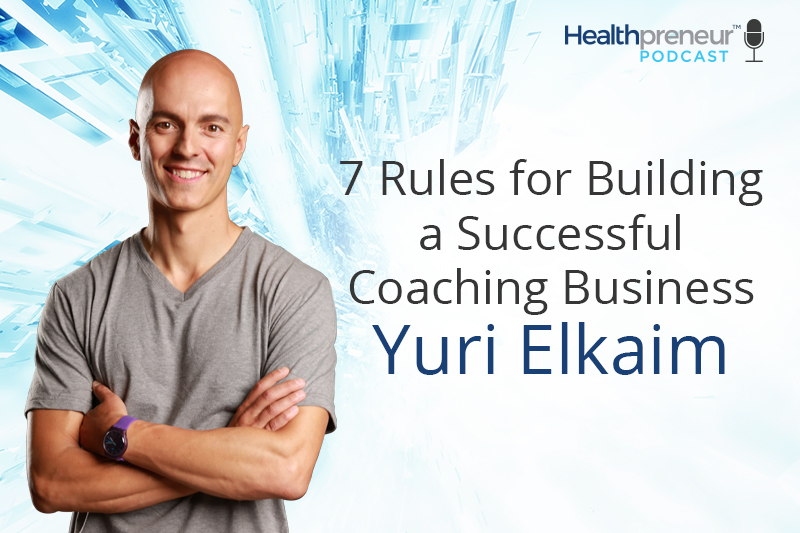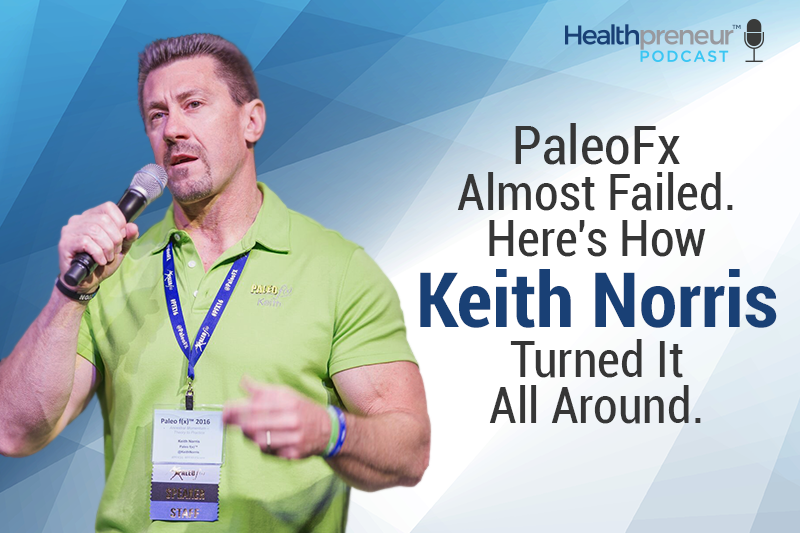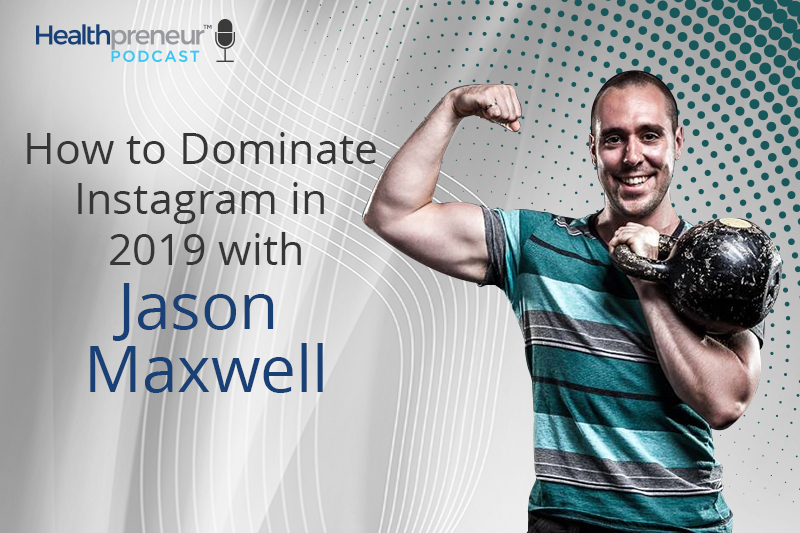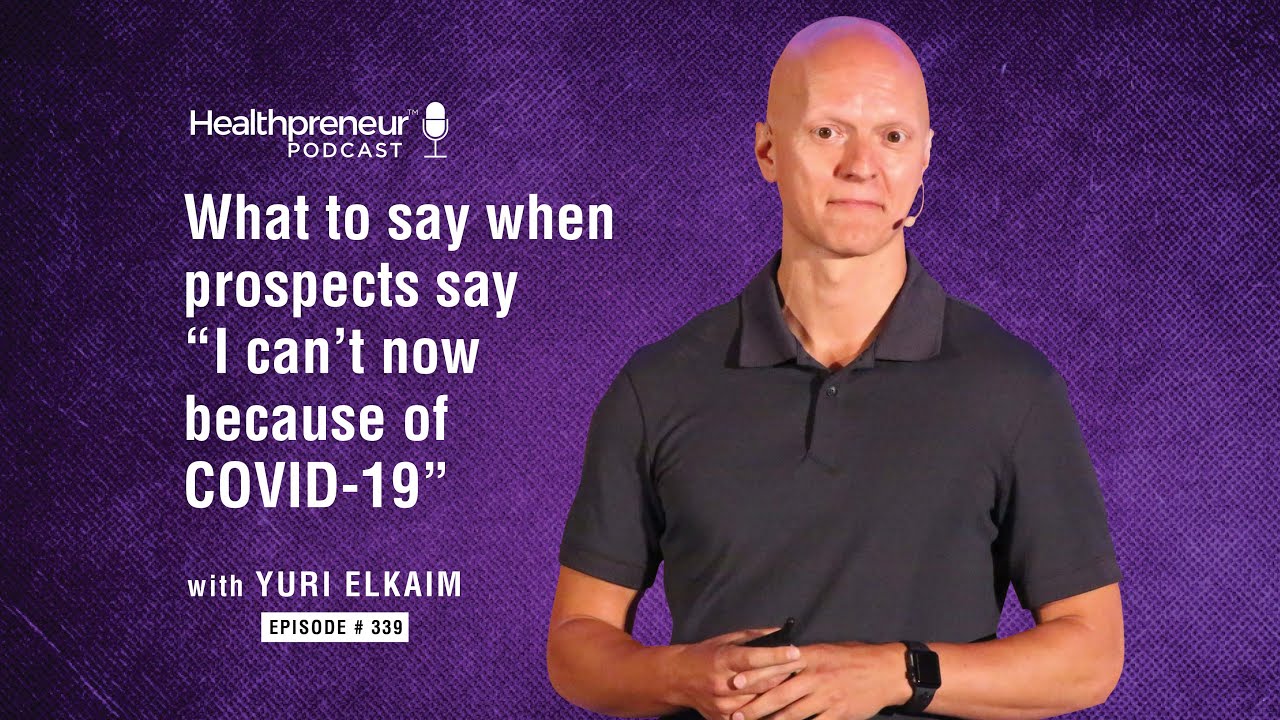7 Rules for Building a Successful Coaching Business

Welcome to another Healthpreneur Podcast from me to you! Today I’m going to reveal the seven rules to creating a successful health coaching business.
Because of my experience for the past 13 years, I can confidently coach others in creating a health coaching business thatlasts. I know what it takes to create a successful business because I’ve done it – and I’m here to show you how you can, too.
Listen in to hear the seven rules that – when followed – will ensure you have a company that creates an impact for you and your clients, makes a difference in the industry, and provides you with the lifestyle and return that you deserve. Follow these rules and watch your business thrive for years to come.
In this episode I discuss:
1:00 – 2:30 – My history in this industry, results, and why longevity matters
2:30 – 9:30 – Solving a pain point, providing the best solution, and pricing higher than the rest
9:30 – 13:00 – Showing you care, prioritizing results, and using simplified frameworks
13:00 – 15:00 – Ask more, teach less, and ask prompting questions
15:00 – 16:30- A recap of the rules and how we can help map out your path
Transcription
Hey guys. Welcome back to another episode of the Healthpreneur podcast, a solo round addition and today we’re talking about seven rules for building a successful health coaching business.
My history in this industry, results, and why longevity matters
I’m very blessed to have built two 7-figure, multiple 7-figure businesses over the past almost 13 years now. It’s been an amazing ride, ups and downs, lots of lessons learned. And I don’t want to blow my own horn, but I need to tell you that there are very few people who have been around since 2006 when I started, who’ve had the success that I’ve enjoyed to be able to be in a position to now coach and teach others.
There’s a lot of people and I’m not discounting or putting down anyone, you just want to be careful who you’re getting advice from because there’s a lot of people who have like one great year and all of a sudden are coaching other people how to build a business.
One of the things that I’ve recognized is that longevity really matters. There’s a very big difference between having one year of good results and having 13 years of good results. And what I want to share with you in this episode are seven rules that I’ve uncovered over this time that is really going to help you build specifically a very profitable and successful coaching business.
Now, these same rules will apply if you’re selling a product. So it doesn’t really matter if you’re selling coaching or products, these same rules apply. And without any further ado, shall we jump into them? All right, let’s do this.
Solve A Major Pain or Problem
So rule number one is you need to be able to solve a major pain or problem. That’s the fundamental reason for existence for a business. A businesses should only exist to solve problems and make life better, easier for their clients or customers. So if you’re not solving a major pain or problem for people, then you’re not going to be doing very well in business. Ideally a business, a product, a service, an offering should really be a ‘must have’, instead of a ‘nice to have’. And so what we’ve typically seen over the years is that wherever there’s a lot of pain and urgency, you’re going to have better results in terms of enrollments or conversions. So that’s the first thing, is you need to solve a major pain or problem.
Provide The Best Solution
The second rule is that you need to provide a unique solution or one solution that’s 10 times better than what currently exists.
There’s a really good book called Breakthrough Advertising by Eugene Schwartz. I don’t even know if it’s sold anymore, it’s probably like $900 on Amazon, but it’s one of the only copywriting books/direct response books that I have that I strongly recommend everyone devour. One of the elements in that book, and this is something we talk about with our clients a lot, is when you work in a sophisticated market like the health and fitness industry, you can’t just come up with another weight loss offer, another weight loss product, another supplement that’s the same as everyone else’s. I’m still baffled by how some people who’ve been in business for a long time, I’m still amazed with the fact that we come up with stuff that is like, “Why would you do that?” Like it’s exactly the same as this other thing. The only difference is that they have a following, so they’re basically selling the same thing to their existing following.
But for most people, if you don’t have a large established following, you need to be able to create something that’s going to stand out, and when people are exposed to it, they’re going to be like, “Wow, this is different. I’ve never seen this before.” Or, “This is way better than what currently exists.”
So let’s look at an example. Let’s look at Apple. I have Mac everything and just recently bought some AirPods, which are the wireless headphones. Now for the longest time I never understood why apple did what they were doing I think post Steve Jobs. Before I get to the AirPods, let’s talk about the iPhone for a second. I wouldn’t say I’m an early adopter, so I’m not one of those guys who lines up days in advance to get the new iPhone, but my wife bought me the iPhone X for Christmas. And I had a 6S before that. And I was extremely grateful for my wife for buying the phone, but it’s a thousand dollar phone and I’m thinking to myself, “The 6S was honestly amazing.”
I mean the camera obviously is better on the iPhone X, but I like the 6S because it’s smaller, it’s more nimble, it’s lighter. I actually use it still for my workout or if I’m running. I don’t carry around my iPhone X when I’m doing stuff like that because it’s so big and bulky. I mean obviously they’re a trillion dollar valuation company, so I can’t really speak poorly about what they’re doing, but I’m saying like what they’re bringing out are products that are marginally better than previous versions of the same products. Right? “Oh cool, a unique color with this one.” Or, “This one has a slightly better camera.” Like these are things that you can’t really get away with unless you’re Apple. And you’ve got to come to the market with something that is going to blow people’s minds.
So let’s look at the AirPods as an example. This, I believe is a breakthrough solution. I bought them because I was sick and tired of working out with the frigging wire getting stuck between my shorts and the handlebars on my fly wheel bike and I’m like, “It’d be so much easier if I just had wireless headphones. Oh my God, why don’t I get some AirPods?” And so the AirPods were able to solve that, but they were also able to solve another big problem which is being able to have conversations via Skype or zoom without being attached physically to my computer, and even taking phone calls a lot easier. And I didn’t have to use all sorts of different headphones all the time. So this is an example of a solution that is so much better than what currently exists.
Now, don’t let this dissuade you from moving forward with what it is you’re coming out with, because the reality is most of us are not developing AirPods. The majority of us are selling a weight loss program, some sort of coaching program that is going to be geared towards a specific outcome and it might very well be similar to other things that are out there. Don’t look at the competition, don’t worry about what they are doing. Don’t copy them, don’t try to do anything in relation to what they’re doing.
You have to have a general understanding of what’s out there in the marketplace, and without getting caught in the weeds and analysis paralysis, you need to figure out, “Okay, I know my clients, I know my audience. What would best serve them?” Or, “If I am my perfect client, what would I want?” And create that. So either you’re providing a unique solution to the marketplace or you’re making something that’s currently out there better in terms of the ability to get results for your clients. So that’s the second rule.
Commanding A Higher Price
Third, is you need to price for coaching or products higher than anyone else. I really believe you have to become a Rolls Royce, or The Four Seasons Hotel of your business, of your marketplace, if you’re selling supplements, sell them three times higher than what everyone else is selling them for.
If you’re selling coaching, don’t ever, ever discount your time, because it’s not going to be worth it. You cannot sell a coaching program for less than a thousand dollars. It’s not worth it in the slightest. If you’re walking people through, supporting them, holding them accountable, and really making sure they get the results, you should be charging a minimum of $3,000 for whatever the duration is. And the duration should ideally be less than three months.
Do not make the mistake of comparing yourself to what other people are pricing at, and using that as, “Okay, I got to price that around what they’re doing.” There’s always going to be a segment of any market, whether it’s dog stuff or workout stuff or sex toys or travel. There’s always going to be a percentage of any market that wants the best.
And usually a higher price means the best. Because you can’t get away with ripping people off if you’re coaching them. If you’re charging $5,000 to help somebody overcome years of emotional eating and you don’t produce results for people, we’re not going to be in business very long, right? So you need to price your coaching based on the results, the outcome that you can get for your clients. So you should be premium priced all the time.
Showing You Care
Number four is show your clients that you actually care. What I love about coaching is that it’s all about going deeper with people not wider. It’s not about acquiring 100,000 customers and hoping that like 100 of them get results. It’s working with let’s say 50 clients and all 50 of them get amazing results. And when you’re charging a premium price, that’s pretty lucrative, right? If you’re charging $5,000 a client and you’re working with 50 clients over the course of a year, that’s a $250,000 business. And acquiring 50 clients is not impossible. It’s actually very feasible if it’s done properly. Now attracting 100,000 customers, buying a $10 ebook, very different proposition. I don’t recommend that at all. So show your clients that you actually care by helping them. Work closely with them. Send them ‘Thank you’ cards. Do things that are just kind of showing them that you’re thinking of them, that they feel appreciated. It’s not rocket science, but this is a big place most businesses drop the ball.
Make Your Clients Your Number One Priority
Number five is tied back into pricing, which is make your client’s results their number one priority. Here’s the nice thing about how we help our clients, is when you have a predictable marketing system that can almost automatically bring in new clients on a daily basis if you wanted, you don’t have to spend as much time on the front end attracting new clients. Which means most of your time is now spent on how can I help my clients get a better result? And the more you improve things, the more you make your program better, the more you get results for your clients, the more you can charge as well. So if you’re increasing the price over time in your program, it’s not because you want to add an extra zero, it’s because you’ve now figured out a way to make it better and by better I mean it helps your clients get better outcomes. So you have to be focused on getting your clients results, otherwise you’re not in business.
Use Simplified Frameworks
Number six, coach using frameworks that simplify complex ideas. I think most people who are experts have the ability to take complex ideas and simplify them. That’s my superpower. That’s a lot of people’s super powers who are health and fitness experts. How do you take this amazingly complex organism called the human body and help people understand how to make it work in a very simple manner? Most people don’t care about the physiology, they don’t care about how things were working, they just want the results. So you need to figure out when you’re coaching people, put the complexity into very simple frameworks that a six year old could understand.
Frameworks are going to give people a fundamental understanding of the building blocks that go into creating a result. And they should be duplicatable stuff. One person follows this framework, it should be the same as somebody else who’s following it as well. So I’m a huge believer in using frameworks because frameworks empower people. When we give somebody the fish, we rob them of the ability to figure things out on their own. But frameworks, we help people learn how to fish, and that empowers them and makes them a better version of themselves, which is what a whole coaching relationship is in the first place. It’s not about doing the work for them, it’s about preparing them for the world ahead, the challenges, the obstacles, the mindset. Really building them up to be better humans.
Ask more, teach less, and ask prompting questions
And finally, along with that is number seven. The seventh rule is ask more and teach less. This is a big mistake that I’ve made and I continue to make, if I’m very honest with you, is I like talking. I think most of us love to hear our own voice and we’ve got so much stuff to share. So if you’re doing a coaching call, a lot of times people are coming up with a problem and we tend to jump in with the answer. We tend to jump in with the solution, “Okay, here’s what I think you should do.” And that’s a very, very strong tendency for almost all coaches that I’ve ever worked with and helped. And this is something I’ve had to catch myself even as recent as yesterday, is instead of me jumping in and giving the solution, it’s let them speak for a second and then ask them a question that’s going to help them figure out the answer themselves.Because if they can figure out the answer to their own problems now, that’s cemented in the nervous system a lot more effectively than if we just tell them what to do.
Again, there’s a great book, it’s called The Coaching Habit and I wish I could remember the author’s names. I can’t, but it’s called The Coaching Habit. Another quick read. It’s a really good book. It gives you seven simple questions and powerful questions really to ask your coaching clients. And one of the questions that I love from these seven questions goes along the lines of this, “What specifically do you need help with?” Just that question helps clarify where they need help. Because a lot of times people are just like rambling and say, “Okay, what’s the specific issue? What specifically do you need help with?” Now let’s say they clarify that and they give it to you. “All right, I’m not too sure how to get up in the morning, get motivated to workout”, whatever it is. Instead of jumping and saying, “Well, here’s what you should do”, you might ask a probing question like, “Well why do you think that is?” And then they can go on and go and talk about it and then you can ask him another question which might be like, “And what else?”
So all we’re doing is we’re asking prompting questions that are going to help them kind between the two of us, but mostly on them facilitate an answer that they’re coming up with. And obviously in certain cases, there is a time where you jump in and you kind of give your advice, but really try to reserve that and let the client really figure things out. It shouldn’t be easy all the time for them. They need to go through this work.
A recap of the rules and how we can help map out your path
So those are the seven rules to building a successful coaching business. Let me just recap them real quick. Number one, solve major problem. Number two, provided unique solution or something that’s 10 times better than what exists. Three, price higher. Four, show the clients you actually care. Five, make their results number one priority. Six, coaches and frameworks. Seven, ask more, teach less. Cool?
Now, if you want help building out a coaching program and a business that’s successful for you, once again, you know where to go. We’ve got a great training called the 7-Figure Health Business Blueprint. We’re going to walk you through the whole thing.
Just go to healthpreneurgroup.com/training.
If you like what you see, you’ll be able to book a call with our team. Now we can get on the phone a few and really map out the best path for you and your business. Okay? So that’s what I’d like you to do right now.
Thank you so much for joining me. If you’ve enjoyed the podcast, we’ve got lots more coming your way. Be sure to subscribe on iTunes to the Healthpreneur Podcast. In the meantime, thank you for joining me. Continue to be great to do great and I’ll see you on Wednesday.
If you enjoyed this episode, head on over to iTunes and subscribe to Healthpreneur™ Podcast if you haven’t done so already.
While you’re there, leave a rating and review. It really helps us out to reach more people because that is what we’re here to do.
What You Missed
Our last episode featured Cassie Bjork, an industry leader in weight loss, speaker, and international best-selling author of the book, “Why Am I Still Fat: The Hidden Keys to Unlocking That Stubborn Weight Loss”.
This is a really telling episode as Cassie shared some things about the industry that are somewhat disturbing if you are any kind of licensed practitioner.
Cassie has gone through some major Schiza, and when you listen to this episode, you’re going to discover some pretty shady things that are happening in the dietitian space, but also this translates over into the naturopathic space as well.
Listen in as Cassie tells us why she let go of her dietician license, and why, surprisingly enough, she’s more aligned with her mission and herself now more than ever.
You can check out the full episode right here: The Shady Side of the Dietetian Industry with Cassie Bjork
Related posts
October 16, 2017
PaleoFx Almost Failed. Here’s How Keith Norris Turned It All Around
Throw out the name of a top…
April 19, 2020
What To Say When Prospects Say “I Can’t Now Because Of COVID-19”
In this episode I want to…





